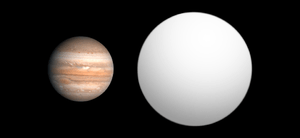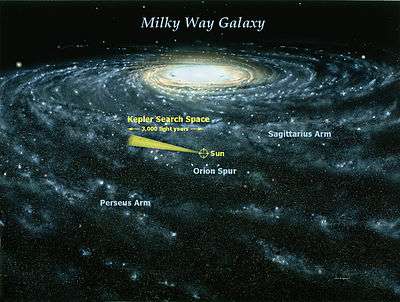Exoplanetology
Exoplanetology, or exoplanetary science, is an integrated field of astronomical science dedicated to the search for and study of exoplanets (extrasolar planets). It employs an interdisciplinary approach which includes astrobiology, astrophysics, astronomy, astrochemistry, astrogeology, geochemistry, and planetary science.
Nomenclature
The exoplanet naming convention is an extension of the system used for naming multiple-star systems as adopted by the International Astronomical Union (IAU). For an exoplanet orbiting a single star, the name is normally formed by taking the name of its parent star and adding a lowercase letter. The first planet discovered in a system is given the designation "b" (the parent star is considered to be "a") and later planets are given subsequent letters. If several planets in the same system are discovered at the same time, the closest one to the star gets the next letter, followed by the other planets in order of orbit size. A provisional IAU-sanctioned standard exists to accommodate the naming of circumbinary planets. A limited number of exoplanets have IAU-sanctioned proper names. Other naming systems exist.
Detection methods
Direct imaging
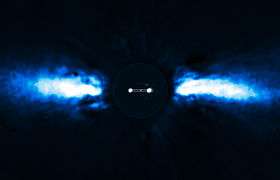
Planets are extremely faint compared with their parent stars. For example, a Sun-like star is about a billion times brighter than the reflected light from any exoplanet orbiting it. It is difficult to detect such a faint light source, and furthermore the parent star causes a glare that tends to wash it out. It is necessary to block the light from the parent star in order to reduce the glare while leaving the light from the planet detectable; doing so is a major technical challenge which requires extreme optothermal stability.[1] All exoplanets that have been directly imaged are both large (more massive than Jupiter) and widely separated from their parent star.
Specially designed direct-imaging instruments such as Gemini Planet Imager, VLT-SPHERE, and SCExAO will image dozens of gas giants, but the vast majority of known extrasolar planets have only been detected through indirect methods. The following are the indirect methods that have proven useful:
Indirect methods
- Transit method
- If a planet crosses (or transits) in front of its parent star's disk, then the observed brightness of the star drops by a small amount. The amount by which the star dims depends on its size and on the size of the planet, among other factors. Because the transit method requires that the planet's orbit intersect a line-of-sight between the host star and Earth, the probability that an exoplanet in a randomly oriented orbit will be observed to transit the star is somewhat small. The Kepler telescope used this method.
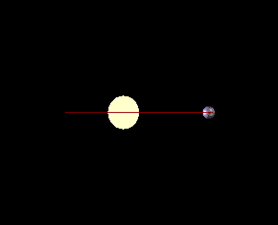 When the star is behind a planet, its brightness will seem to dim
When the star is behind a planet, its brightness will seem to dim

|
direct imaging microlensing |
transit timing |
radial velocity |
- As a planet orbits a star, the star also moves in its own small orbit around the system's center of mass. Variations in the star's radial velocity—that is, the speed with which it moves towards or away from Earth—can be detected from displacements in the star's spectral lines due to the Doppler effect. Extremely small radial-velocity variations can be observed, of 1 m/s or even somewhat less.[2]
- Transit timing variation (TTV)
- When multiple planets are present, each one slightly perturbs the others' orbits. Small variations in the times of transit for one planet can thus indicate the presence of another planet, which itself may or may not transit. For example, variations in the transits of the planet Kepler-19b suggest the existence of a second planet in the system, the non-transiting Kepler-19c.[3][4]
- Transit duration variation (TDV)
- When a planet orbits multiple stars or if the planet has moons, its transit time can significantly vary per transit. Although no new planets or moons have been discovered with this method, it is used to successfully confirm many transiting circumbinary planets.[5]
- Gravitational microlensing
- Microlensing occurs when the gravitational field of a star acts like a lens, magnifying the light of a distant background star. Planets orbiting the lensing star can cause detectable anomalies in the magnification as it varies over time. Unlike most other methods which have detection bias towards planets with small (or for resolved imaging, large) orbits, microlensing method is most sensitive to detecting planets around 1–10 AU away from Sun-like stars.
- Astrometry
- Astrometry consists of precisely measuring a star's position in the sky and observing the changes in that position over time. The motion of a star due to the gravitational influence of a planet may be observable. Because the motion is so small, however, this method has not yet been very productive. It has produced only a few disputed detections, though it has been successfully used to investigate the properties of planets found in other ways.
- Pulsar timing
- A pulsar (the small, ultradense remnant of a star that has exploded as a supernova) emits radio waves extremely regularly as it rotates. If planets orbit the pulsar, they will cause slight anomalies in the timing of its observed radio pulses. The first confirmed discovery of an extrasolar planet was made using this method. But as of 2011, it has not been very productive; five planets have been detected in this way, around three different pulsars.
- Variable star timing (pulsation frequency)
- Like pulsars, there are some other types of stars which exhibit periodic activity. Deviations from the periodicity can sometimes be caused by a planet orbiting it. As of 2013, a few planets have been discovered with this method.[6]
- Reflection/emission modulations
- When a planet orbits very close to the star, it catches a considerable amount of starlight. As the planet orbits around the star, the amount of light changes due to planets having phases from Earth's viewpoint or planet glowing more from one side than the other due to temperature differences.[7]
- Relativistic beaming
- Relativistic beaming measures the observed flux from the star due to its motion. The brightness of the star changes as the planet moves closer or further away from its host star.[8]
- Ellipsoidal variations
- Massive planets close to their host stars can slightly deform the shape of the star. This causes the brightness of the star to slightly deviate depending how it is rotated relative to Earth.[9]
- Polarimetry
- With polarimetry method, a polarized light reflected off the planet is separated from unpolarized light emitted from the star. No new planets have been discovered with this method although a few already discovered planets have been detected with this method.[10][11]
- Circumstellar disks
- Disks of space dust surround many stars, thought to originate from collisions among asteroids and comets. The dust can be detected because it absorbs starlight and re-emits it as infrared radiation. Features in the disks may suggest the presence of planets, though this is not considered a definitive detection method.
Orbital parameters
Most known extrasolar planet candidates have been discovered using indirect methods and therefore only some of their physical and orbital parameters can be determined. For example, out of the six independent parameters that define an orbit, the radial-velocity method can determine four: semi-major axis, eccentricity, longitude of periastron, and time of periastron. Two parameters remain unknown: inclination and longitude of the ascending node.
Distance from star and orbital period
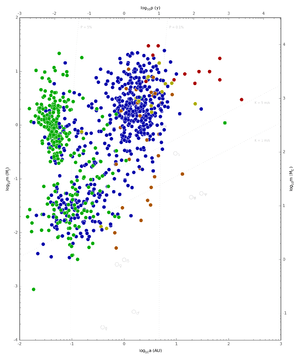
|
transit
|
radial velocity
direct imaging |
There are exoplanets that are much closer to their parent star than any planet in the Solar System is to the Sun, and there are also exoplanets that are much further from their star. Mercury, the closest planet to the Sun at 0.4 astronomical units (AU), takes 88 days for an orbit, but the smallest known orbits of exoplanets have orbital periods of only a few hours, see Ultra-short period planet. The Kepler-11 system has five of its planets in smaller orbits than Mercury's. Neptune is 30 AU from the Sun and takes 165 years to orbit it, but there are exoplanets that are thousands of AU from their star and take tens of thousands of years to orbit, e.g. GU Piscium b.[12]
The radial-velocity and transit methods are most sensitive to planets with small orbits. The earliest discoveries such as 51 Peg b were gas giants with orbits of a few days.[13] These "hot Jupiters" likely formed further out and migrated inwards.
The direct imaging method is most sensitive to planets with large orbits, and has discovered some planets that have planet–star separations of hundreds of AU. However, protoplanetary disks are usually only around 100 AU in radius, and core accretion models predict giant planet formation to be within 10 AU, where the planets can coalesce quickly enough before the disk evaporates. Very-long-period giant planets may have been rogue planets that were captured,[14] or formed close-in and gravitationally scattered outwards, or the planet and star could be a mass-imbalanced wide binary system with the planet being the primary object of its own separate protoplanetary disk. Gravitational instability models might produce planets at multi-hundred AU separations but this would require unusually large disks.[15][16] For planets with very wide orbits up to several hundred thousand AU it may be difficult to observationally determine whether the planet is gravitationally bound to the star.
Most planets that have been discovered are within a couple of AU from their host star because the most used methods (radial-velocity and transit) require observation of several orbits to confirm that the planet exists and there has only been enough time since these methods were first used to cover small separations. Some planets with larger orbits have been discovered by direct imaging but there is a middle range of distances, roughly equivalent to the Solar System's gas giant region, which is largely unexplored. Direct imaging equipment for exploring that region was installed on two large telescopes that began operation in 2014, e.g. Gemini Planet Imager and VLT-SPHERE. The microlensing method has detected a few planets in the 1–10 AU range.[17] It appears plausible that in most exoplanetary systems, there are one or two giant planets with orbits comparable in size to those of Jupiter and Saturn in the Solar System. Giant planets with substantially larger orbits are now known to be rare, at least around Sun-like stars.[18]
The distance of the habitable zone from a star depends on the type of star and this distance changes during the star's lifetime as the size and temperature of the star changes.
Eccentricity
The eccentricity of an orbit is a measure of how elliptical (elongated) it is. All the planets of the Solar System except for Mercury have near-circular orbits (e<0.1).[19] Most exoplanets with orbital periods of 20 days or less have near-circular orbits, i.e. very low eccentricity. That is thought to be due to tidal circularization: reduction of eccentricity over time due to gravitational interaction between two bodies. The mostly sub-Neptune-sized planets found by the Kepler spacecraft with short orbital periods have very circular orbits.[20] By contrast, the giant planets with longer orbital periods discovered by radial-velocity methods have quite eccentric orbits. (As of July 2010, 55% of such exoplanets have eccentricities greater than 0.2, whereas 17% have eccentricities greater than 0.5.[21]) Moderate to high eccentricities (e>0.2) of giant planets are not an observational selection effect, because a planet can be detected about equally well regardless of the eccentricity of its orbit. The statistical significance of elliptical orbits in the ensemble of observed giant planets is somewhat surprising, because current theories of planetary formation suggest that low-mass planets should have their orbital eccentricity circularized by gravitational interactions with the surrounding protoplanetary disk.[22][23] However, as a planet grows more massive and its interaction with the disk becomes nonlinear, it may induce eccentric motion of the surrounding disk's gas, which in turn may excite the planet's orbital eccentricity.[24][25][26] Low eccentricities are correlated with high multiplicity (number of planets in the system).[27] Low eccentricity is needed for habitability, especially advanced life.[28]
For weak Doppler signals near the limits of the current detection ability, the eccentricity becomes poorly constrained and biased towards higher values. It is suggested that some of the high eccentricities reported for low-mass exoplanets may be overestimates, because simulations show that many observations are also consistent with two planets on circular orbits. Reported observations of single planets in moderately eccentric orbits have about a 15% chance of being a pair of planets.[29] This misinterpretation is especially likely if the two planets orbit with a 2:1 resonance. With the exoplanet sample known in 2009, a group of astronomers estimated that "(1) around 35% of the published eccentric one-planet solutions are statistically indistinguishable from planetary systems in 2:1 orbital resonance, (2) another 40% cannot be statistically distinguished from a circular orbital solution" and "(3) planets with masses comparable to Earth could be hidden in known orbital solutions of eccentric super-Earths and Neptune mass planets".[30]
Radial velocity surveys found exoplanet orbits beyond 0.1 AU to be eccentric, particularly for large planets. Transit data obtained by the Kepler spacecraft, is consistent with the RV surveys and also revealed that smaller planets tend to have less eccentric orbits.[31]
Inclination vs. spin–orbit angle
Orbital inclination is the angle between a planet's orbital plane and another plane of reference. For exoplanets, the inclination is usually stated with respect to an observer on Earth: the angle used is that between the normal to the planet's orbital plane and the line of sight from Earth to the star. Therefore, most planets observed by the transit method are close to 90 degrees.[32] Because the word 'inclination' is used in exoplanet studies for this line-of-sight inclination then the angle between the planet's orbit and the star's rotation must use a different word and is termed the spin–orbit angle or spin–orbit alignment. In most cases the orientation of the star's rotational axis is unknown. The Kepler spacecraft has found a few hundred multi-planet systems and in most of these systems the planets all orbit in nearly the same plane, much like the Solar System.[20] However, a combination of astrometric and radial-velocity measurements has shown that some planetary systems contain planets whose orbital planes are significantly tilted relative to each other.[33] More than half of hot Jupiters have orbital planes substantially misaligned with their parent star's rotation. A substantial fraction of hot-Jupiters even have retrograde orbits, meaning that they orbit in the opposite direction from the star's rotation.[34] Rather than a planet's orbit having been disturbed, it may be that the star itself flipped early in their system's formation due to interactions between the star's magnetic field and the planet-forming disk.[35]
Periastron precession
Periastron precession is the rotation of a planet's orbit within the orbital plane, i.e. the axes of the ellipse change direction. In the Solar System, perturbations from other planets are the main cause, but for close-in exoplanets the largest factor can be tidal forces between the star and planet. For close-in exoplanets, the general relativistic contribution to the precession is also significant and can be orders of magnitude larger than the same effect for Mercury. Some exoplanets have significantly eccentric orbits, which makes it easier to detect the precession. The effect of general relativity can be detectable in timescales of about 10 years or less.[36]
Nodal precession
Nodal precession is rotation of a planet's orbital plane. Nodal precession is more easily seen as distinct from periastron precession when the orbital plane is inclined to the star's rotation, the extreme case being a polar orbit.
WASP-33 is a fast-rotating star that hosts a hot Jupiter in an almost polar orbit. The quadrupole mass moment and the proper angular momentum of the star are 1900 and 400 times, respectively, larger than those of the Sun. This causes significant classical and relativistic deviations from Kepler's laws. In particular, the fast rotation causes large nodal precession because of the star's oblateness and the Lense–Thirring effect.[37]
Rotation and axial tilt
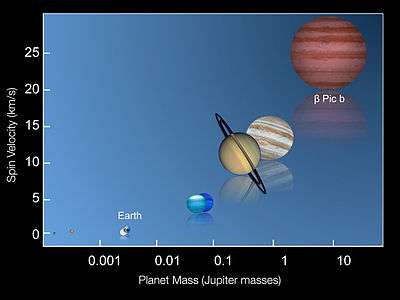
In April 2014, the first measurement of a planet's rotation period was announced: the length of day for the super-Jupiter gas giant Beta Pictoris b is 8 hours (based on the assumption that the axial tilt of the planet is small.)[38][39][40] With an equatorial rotational velocity of 25 km per second, this is faster than for the giant planets of the Solar System, in line with the expectation that the more massive a giant planet, the faster it spins. Beta Pictoris b's distance from its star is 9 AU. At such distances the rotation of Jovian planets is not slowed by tidal effects.[41] Beta Pictoris b is still warm and young and over the next hundreds of millions of years, it will cool down and shrink to about the size of Jupiter, and if its angular momentum is preserved, then as it shrinks, the length of its day will decrease to about 3 hours and its equatorial rotation velocity will speed up to about 40 km/s.[39] The images of Beta Pictoris b do not have high enough resolution to directly see details but doppler spectroscopy techniques were used to show that different parts of the planet were moving at different speeds and in opposite directions from which it was inferred that the planet is rotating.[38] With the next generation of large ground-based telescopes it will be possible to use doppler imaging techniques to make a global map of the planet, like the mapping of the brown dwarf Luhman 16B in 2014.[42][43] A 2017 study of the rotation of several gas giants found no correlation between rotation rate and mass of the planet.[44]
Origin of spin and tilt of terrestrial planets
Giant impacts have a large effect on the spin of terrestrial planets. The last few giant impacts during planetary formation tend to be the main determiner of a terrestrial planet's rotation rate. On average the spin angular velocity will be about 70% of the velocity that would cause the planet to break up and fly apart; the natural outcome of planetary embryo impacts at speeds slightly larger than escape velocity. In later stages terrestrial planet spin is also affected by impacts with planetesimals. During the giant impact stage, the thickness of a protoplanetary disk is far larger than the size of planetary embryos so collisions are equally likely to come from any direction in three-dimensions. This results in the axial tilt of accreted planets ranging from 0 to 180 degrees with any direction as likely as any other with both prograde and retrograde spins equally probable. Therefore, prograde spin with a small axial tilt, common for the Solar System's terrestrial planets except Venus, is not common in general for terrestrial planets built by giant impacts. The initial axial tilt of a planet determined by giant impacts can be substantially changed by stellar tides if the planet is close to its star and by satellite tides if the planet has a large satellite.[45]
Tidal effects
For most planets, the rotation period and axial tilt (also called obliquity) are not known, but a large number of planets have been detected with very short orbits (where tidal effects are greater) that will probably have reached an equilibrium rotation that can be predicted (i.e. tidal lock, spin–orbit resonances, and non-resonant equilibria such as retrograde rotation).[41]
Gravitational tides tend to reduce the axial tilt to zero but over a longer timescale than the rotation rate reaches equilibrium. However, the presence of multiple planets in a system can cause axial tilt to be captured in a resonance called a Cassini state. There are small oscillations around this state and in the case of Mars these axial tilt variations are chaotic.[41]
Hot Jupiters' close proximity to their host star means that their spin–orbit evolution is mostly due to the star's gravity and not the other effects. Hot Jupiters' rotation rate is not thought to be captured into spin–orbit resonance because of the way in which such a fluid-body reacts to tides; a planet like this therefore slows down into synchronous rotation if its orbit is circular, or, alternatively, it slows down into a non-synchronous rotation if its orbit is eccentric. Hot Jupiters are likely to evolve towards zero axial tilt even if they had been in a Cassini state during planetary migration when they were further from their star. Hot Jupiters' orbits will become more circular over time, however the presence of other planets in the system on eccentric orbits, even ones as small as Earth and as far away as the habitable zone, can continue to maintain the eccentricity of the Hot Jupiter so that the length of time for tidal circularization can be billions instead of millions of years.[41]
The rotation rate of planet HD 80606 b is predicted to be about 1.9 days.[41] HD 80606 b avoids spin–orbit resonance because it is a gas giant. The eccentricity of its orbit means that it avoids becoming tidally locked.
Physical parameters
Mass
When a planet is found by the radial-velocity method, its orbital inclination i is unknown and can range from 0 to 90 degrees. The method is unable to determine the true mass (M) of the planet, but rather gives a lower limit for its mass, M sini. In a few cases an apparent exoplanet may be a more massive object such as a brown dwarf or red dwarf. However, the probability of a small value of i (say less than 30 degrees, which would give a true mass at least double the observed lower limit) is relatively low (1−√3/2 ≈ 13%) and hence most planets will have true masses fairly close to the observed lower limit.[13]
If a planet's orbit is nearly perpendicular to the line of vision (i.e. i close to 90°), a planet can be detected through the transit method. The inclination will then be known, and the inclination combined with M sini from radial-velocity observations will give the planet's true mass.
Also, astrometric observations and dynamical considerations in multiple-planet systems can sometimes provide an upper limit to the planet's true mass.
In 2013 it was proposed that the mass of a transiting exoplanet can also be determined from the transmission spectrum of its atmosphere, as it can be used to constrain independently the atmospheric composition, temperature, pressure, and scale height,[46] however a 2017 study found that the transmission spectrum cannot unambiguously determine the mass.[47]
Transit-timing variation can also be used to find a planet's mass.[48]
Radius, density, and bulk composition
Prior to recent results from the Kepler space observatory, most confirmed planets were gas giants comparable in size to Jupiter or larger because they are most easily detected. However, the planets detected by Kepler are mostly between the size of Neptune and the size of Earth.[20]
If a planet is detectable by both the radial-velocity and the transit methods, then both its true mass and its radius can be determined, as well as its density. Planets with low density are inferred to be composed mainly of hydrogen and helium, whereas planets of intermediate density are inferred to have water as a major constituent. A planet of high density is inferred to be rocky, like Earth and the other terrestrial planets of the Solar System.

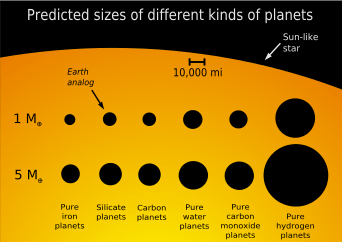
Gas giants, puffy planets, and super-Jupiters
Gaseous planets that are hot are caused by extreme proximity to their host star, or because they are still hot from their formation and are expanded by the heat. For colder gas planets, there is a maximum radius which is slightly larger than Jupiter which occurs when the mass reaches a few Jupiter-masses. Adding mass beyond this point causes the radius to shrink.[49][50][51]
Even when taking heat from the star into account, many transiting exoplanets are much larger than expected given their mass, meaning that they have surprisingly low density.[52] See the magnetic field section for one possible explanation.

Besides the inflated hot Jupiters, there is another type of low-density planet: super-puffs with masses only a few times Earth's but with radii larger than Neptune. The planets around Kepler-51[53] are far less dense (far more diffuse) than the inflated hot Jupiters as can be seen in the plots on the right where the three Kepler-51 planets stand out in the diffusity vs. radius plot.
Ice giants and super-Neptunes
Kepler-101b was the first super-Neptune discovered. It has three times Neptune's mass but its density suggests that heavy elements make up more than 60% of its total mass, unlike hydrogen–helium-dominated gas giants.[54]
Super-Earths, mini-Neptunes, and gas dwarfs
If a planet has a radius and/or mass between that of Earth and Neptune, then there is a question about whether the planet is rocky like Earth, a mixture of volatiles and gas like Neptune, a small planet with a hydrogen/helium envelope (mini-Jupiter), or of some other composition.
Some of the Kepler transiting planets with radii in the range of 1–4 Earth radii have had their masses measured by radial-velocity or transit-timing methods. The calculated densities show that up to 1.5 Earth radii, these planets are rocky and that density increases with increasing radius due to gravitational compression. However, between 1.5 and 4 Earth radii the density decreases with increasing radius. This indicates that above 1.5 Earth radii, planets tend to have increasing amounts of volatiles and gas. Despite this general trend, there is a wide range of masses at a given radius, which could be because gas planets can have rocky cores of different masses and compositions,[55] and could also be due to photoevaporation of volatiles.[56] Thermal evolutionary atmosphere models suggest a radius of 1.75 times that of Earth as a dividing line between rocky and gaseous planets.[57] Excluding close-in planets that have lost their gas envelope due to stellar irradiation, studies of the metallicity of stars suggest a dividing line of 1.7 Earth radii between rocky planets and gas dwarfs, then another dividing line at 3.9 Earth radii between gas dwarfs and gas giants. These dividing lines are statistical trends and do not apply universally, because there are many other factors besides metallicity that affect planet formation, including distance from star – there may be larger rocky planets that formed at larger distances.[58] An independent reanalysis of the data suggests that there are no such dividing lines and that there is a continuum of planet formation between 1 and 4 Earth radii and no reason to suspect that the amount of solid material in a protoplanetary disk determines whether super-Earths or mini-Neptunes form.[59] Studies done in 2016 based on over 300 planets suggest that most objects over approximately two Earth masses collect significant hydrogen–helium envelopes, meaning rocky super-Earths may be rare.[60]
The discovery of the low-density Earth-mass planet Kepler-138d shows that there is an overlapping range of masses in which both rocky planets and low-density planets occur.[61] A low-mass low-density planets could be an ocean planet or super-Earth with a remnant hydrogen atmosphere, or a hot planet with a steam atmosphere, or a mini-Neptune with a hydrogen–helium atmosphere.[62] Another possibility for a low-mass low-density planet is that it has a large atmosphere made up chiefly of carbon monoxide, carbon dioxide, methane, or nitrogen.[63]
Massive solid planets
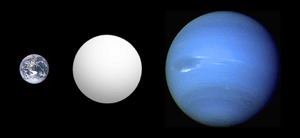
In 2014, new measurements of Kepler-10c found it to be a Neptune-mass planet (17 Earth masses) with a density higher than Earth's, indicating that Kepler-10c is composed mostly of rock with possibly up to 20% high-pressure water ice but without a hydrogen-dominated envelope. Because this is well above the 10-Earth-mass upper limit that is commonly used for the term 'super-Earth', the term mega-Earth has been coined.[64][65] A similarly massive and dense planet could be Kepler-131b, although its density is not as well measured as that of Kepler 10c. The next most massive known solid planets are half this mass: 55 Cancri e and Kepler-20b.[66]
Gas planets can have large solid cores. The Saturn-mass planet HD 149026 b has only two-thirds of Saturn's radius, so it may have a rock–ice core of 60 Earth masses or more.[49] Corot-20b has 4.24 times Jupiter's mass but a radius of only 0.84 that of Jupiter; it may have a metal core of 800 Earth masses if the heavy elements are concentrated in the core, or a core of 300 Earth masses if the heavy elements are more distributed throughout the planet.[67][68]
Transit-timing variation measurements indicate that Kepler-52b, Kepler-52c and Kepler-57b have maximum masses between 30 and 100 times that of Earth, although the actual masses could be much lower. With radii about 2 Earth radii[69] in size, they might have densities larger than that of an iron planet of the same size. They orbit very close to their stars, so they could each be the remnant core (chthonian planet) of an evaporated gas giant or brown dwarf. If a remnant core is massive enough it could remain in such a state for billions of years despite having lost the atmospheric mass.[70][71]
Solid planets up to thousands of Earth masses may be able to form around massive stars (B-type and O-type stars; 5–120 solar masses), where the protoplanetary disk would contain enough heavy elements. Also, these stars have high UV radiation and winds that could photoevaporate the gas in the disk, leaving just the heavy elements.[72] For comparison, Neptune's mass equals 17 Earth masses, Jupiter has 318 Earth masses, and the 13-Jupiter-mass limit used in the IAU's working definition of an exoplanet equals approximately 4000 Earth masses.[72]
Cold planets have a maximum radius because adding more mass at that point causes the planet to compress under the weight instead of increasing the radius. The maximum radius for solid planets is lower than the maximum radius for gas planets.[72]
Shape
When the size of a planet is described using its radius, this is approximating the shape by a sphere. However, the rotation of a planet causes it to be flattened at the poles; so the equatorial radius is larger than the polar radius, making it closer to an oblate spheroid. The oblateness of transiting exoplanets will affect the transit light curves. At the limits of current technology it has been possible to show that HD 189733b is less oblate than Saturn.[73] If the planet is close to its star, then gravitational tides will elongate the planet in the direction of the star, making the planet closer to a triaxial ellipsoid.[74] Because tidal deformation is along a line between the planet and the star, it is difficult to detect from transit photometry; it will have an effect on the transit light curves an order of magnitude less than that caused by rotational deformation even in cases where tidal deformation is larger than rotational deformation (as is the case for tidally locked hot Jupiters).[73] Material rigidity of rocky planets and rocky cores of gas planets will cause further deviations from the aforementioned shapes.[73] Thermal tides caused by unevenly irradiated surfaces are another factor.[75]
Atmosphere
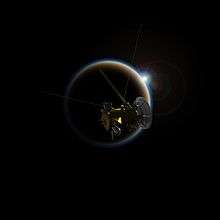
As of February 2014, more than fifty transiting and five directly imaged exoplanet atmospheres have been observed,[76] resulting in detection of molecular spectral features; observation of day–night temperature gradients; and constraints on vertical atmospheric structure.[77] Also, an atmosphere has been detected on the non-transiting hot Jupiter Tau Boötis b.[78][79]
Surface
Surface composition
Surface features can be distinguished from atmospheric features by comparing emission and reflection spectroscopy with transmission spectroscopy. Mid-infrared spectroscopy of exoplanets may detect rocky surfaces, and near-infrared may identify magma oceans or high-temperature lavas, hydrated silicate surfaces and water ice, giving an unambiguous method to distinguish between rocky and gaseous exoplanets.[80]
Surface temperature
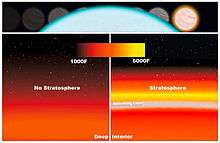
The temperature of an exoplanet can be estimated by measuring the intensity of the light it receives from its parent star. For example, the planet OGLE-2005-BLG-390Lb is estimated to have a surface temperature of roughly −220 °C (50 K). However, such estimates may be substantially in error because they depend on the planet's usually unknown albedo, and because factors such as the greenhouse effect may introduce unknown complications. A few planets have had their temperature measured by observing the variation in infrared radiation as the planet moves around in its orbit and is eclipsed by its parent star. For example, the planet HD 189733b has been estimated to have an average temperature of 1,205 K (932 °C) on its dayside and 973 K (700 °C) on its nightside.[82]
Habitability
Habitable zone
The habitable zone around a star is the region where the temperature is just right to allow liquid water to exist on a planet; that is, not too close to the star for the water to evaporate and not too far away from the star for the water to freeze. The heat produced by stars varies depending on the size and age of the star, so that the habitable zone can be at different distances for different stars. Also, the atmospheric conditions on the planet influence the planet's ability to retain heat so that the location of the habitable zone is also specific to each type of planet: desert planets (also known as dry planets), with very little water, will have less water vapor in the atmosphere than Earth and so have a reduced greenhouse effect, meaning that a desert planet could maintain oases of water closer to its star than Earth is to the Sun. The lack of water also means there is less ice to reflect heat into space, so the outer edge of desert-planet habitable zones is further out.[83][84] Rocky planets with a thick hydrogen atmosphere could maintain surface water much further out than the Earth–Sun distance.[85] Planets with larger mass have wider habitable zones because the gravity reduces the water cloud column depth which reduces the greenhouse effect of water vapor, thus moving the inner edge of the habitable zone closer to the star.[86]
Planetary rotation rate is one of the major factors determining the circulation of the atmosphere and hence the pattern of clouds: slowly rotating planets create thick clouds that reflect more and so can be habitable much closer to their star. Earth with its current atmosphere would be habitable in Venus's orbit, if it had Venus's slow rotation. If Venus lost its water ocean due to a runaway greenhouse effect, it is likely to have had a higher rotation rate in the past. Alternatively, Venus never had an ocean because water vapor was lost to space during its formation [87] and could have had its slow rotation throughout its history.[88]
Tidally locked planets (a.k.a. "eyeball" planets[89]) can be habitable closer to their star than previously thought due to the effect of clouds: at high stellar flux, strong convection produces thick water clouds near the substellar point that greatly increase the planetary albedo and reduce surface temperatures.[90]
Habitable zones have usually been defined in terms of surface temperature, however over half of Earth's biomass is from subsurface microbes,[91] and the temperature increases with depth, so the subsurface can be conducive for microbial life when the surface is frozen and if this is considered, the habitable zone extends much further from the star,[92] even rogue planets could have liquid water at sufficient depths underground.[93] In an earlier era of the universe the temperature of the cosmic microwave background would have allowed any rocky planets that existed to have liquid water on their surface regardless of their distance from a star.[94] Jupiter-like planets might not be habitable, but they could have habitable moons.[95]
Ice ages and snowball states
The outer edge of the habitable zone is where planets are completely frozen, but planets well inside the habitable zone can periodically become frozen. If orbital fluctuations or other causes produce cooling then this creates more ice, but ice reflects sunlight causing even more cooling, creating a feedback loop until the planet is completely or nearly completely frozen. When the surface is frozen, this stops carbon dioxide weathering, resulting in a build-up of carbon dioxide in the atmosphere from volcanic emissions. This creates a greenhouse effect which thaws the planet again. Planets with a large axial tilt[96] are less likely to enter snowball states and can retain liquid water further from their star. Large fluctuations of axial tilt can have even more of a warming effect than a fixed large tilt.[97][98] Paradoxically, planets orbiting cooler stars, such as red dwarfs, are less likely to enter snowball states because the infrared radiation emitted by cooler stars is mostly at wavelengths that are absorbed by ice which heats it up.[99][100]
Tidal heating
If a planet has an eccentric orbit, then tidal heating can provide another source of energy besides stellar radiation. This means that eccentric planets in the radiative habitable zone can be too hot for liquid water. Tides also circularize orbits over time so there could be planets in the habitable zone with circular orbits that have no water because they used to have eccentric orbits.[101] Eccentric planets further out than the habitable zone would still have frozen surfaces but the tidal heating could create a subsurface ocean similar to Europa's.[102] In some planetary systems, such as in the Upsilon Andromedae system, the eccentricity of orbits is maintained or even periodically varied by perturbations from other planets in the system. Tidal heating can cause outgassing from the mantle, contributing to the formation and replenishment of an atmosphere.[103]
Potentially habitable planets
A review in 2015 identified exoplanets Kepler-62f, Kepler-186f and Kepler-442b as the best candidates for being potentially habitable.[104] These are at a distance of 1200, 490 and 1,120 light-years away, respectively. Of these, Kepler-186f is in similar size to Earth with its 1.2-Earth-radius measure, and it is located towards the outer edge of the habitable zone around its red dwarf star.
When looking at the nearest terrestrial exoplanet candidates, Proxima Centauri b is about 4.2 light-years away. Its equilibrium temperature is estimated to be −39 °C (234 K).[105]
Earth-size planets
- In November 2013 it was estimated that 22±8% of Sun-like[lower-alpha 2] stars in the Milky Way galaxy may have an Earth-sized[lower-alpha 3] planet in the habitable[lower-alpha 4] zone.[106][107] Assuming 200 billion stars in the Milky Way,[lower-alpha 5] that would be 11 billion potentially habitable Earths, rising to 40 billion if red dwarfs are included.[108]
- Kepler-186f, a 1.2-Earth-radius planet in the habitable zone of a red dwarf, reported in April 2014.
- Proxima Centauri b, a planet in the habitable zone of Proxima Centauri, the nearest known star to the solar system with an estimated minimum mass of 1.27 times the mass of the Earth.
- In February 2013, researchers speculated that up to 6% of small red dwarfs may have Earth-size planets. This suggests that the closest one to the Solar System could be 13 light-years away. The estimated distance increases to 21 light-years when a 95% confidence interval is used.[109] In March 2013 a revised estimate gave an occurrence rate of 50% for Earth-size planets in the habitable zone of red dwarfs.[110]
- At 1.63 times Earth's radius Kepler-452b is the first discovered near-Earth-size planet in the "habitable zone" around a G2-type Sun-like star (July 2015).[111]
See also
- Carl Sagan Institute – Institute for the search of habitable worlds
- Circumstellar habitable zone – Zone around a star where surface liquid water may exist on a planet
- List of exoplanet search projects
- Lists of exoplanets
- Nexus for Exoplanet System Science – Dedicated to the search for life on exoplanets
- Planetary science – Science of astronomical objects apparently in orbit around one or more stellar objects within a few light years
Notes
- Data from NASA catalog July 2014, excluding objects described as having unphysically high density
- For the purpose of this 1 in 5 statistic, "Sun-like" means G-type star. Data for Sun-like stars was not available so this statistic is an extrapolation from data about K-type stars
- For the purpose of this 1 in 5 statistic, Earth-sized means 1–2 Earth radii
- For the purpose of this 1 in 5 statistic, "habitable zone" means the region with 0.25 to 4 times Earth's stellar flux (corresponding to 0.5–2 AU for the Sun).
- About 1/4 of stars are GK Sun-like stars. The number of stars in the galaxy is not accurately known, but assuming 200 billion stars in total, the Milky Way would have about 50 billion Sun-like (GK) stars, of which about 1 in 5 (22%) or 11 billion would be Earth-sized in the habitable zone. Including red dwarfs would increase this to 40 billion.
References
- Perryman, Michael (2011). The Exoplanet Handbook. Cambridge University Press. p. 149. ISBN 978-0-521-76559-6.
- Pepe, F.; Lovis, C.; Ségransan, D.; Benz, W.; Bouchy, F.; Dumusque, X.; Mayor, M.; Queloz, D.; Santos, N. C.; Udry, S. (2011). "The HARPS search for Earth-like planets in the habitable zone". Astronomy & Astrophysics. 534: A58. arXiv:1108.3447. Bibcode:2011A&A...534A..58P. doi:10.1051/0004-6361/201117055.
- Planet Hunting: Finding Earth-like Planets Archived 2010-07-28 at the Wayback Machine. Scientific Computing. 19 July 2010
- Ballard, S.; Fabrycky, D.; Fressin, F.; Charbonneau, D.; Desert, J. M.; Torres, G.; Marcy, G.; Burke, C. J.; Isaacson, H.; Henze, C.; Steffen, J. H.; Ciardi, D. R.; Howell, S. B.; Cochran, W. D.; Endl, M.; Bryson, S. T.; Rowe, J. F.; Holman, M. J.; Lissauer, J. J.; Jenkins, J. M.; Still, M.; Ford, E. B.; Christiansen, J. L.; Middour, C. K.; Haas, M. R.; Li, J.; Hall, J. R.; McCauliff, S.; Batalha, N. M.; Koch, D. G.; et al. (2011). "The Kepler-19 System: A Transiting 2.2 R⊕ Planet and a Second Planet Detected Via Transit Timing Variations". The Astrophysical Journal. 743 (2): 200. arXiv:1109.1561. Bibcode:2011ApJ...743..200B. doi:10.1088/0004-637X/743/2/200.
- Pál, A.; Kocsis, B. (2008). "Periastron Precession Measurements in Transiting Extrasolar Planetary Systems at the Level of General Relativity". Monthly Notices of the Royal Astronomical Society. 389 (1): 191–198. arXiv:0806.0629. Bibcode:2008MNRAS.389..191P. doi:10.1111/j.1365-2966.2008.13512.x.
- Silvotti, R.; Schuh, S.; Janulis, R.; Solheim, J. -E.; Bernabei, S.; Østensen, R.; Oswalt, T. D.; Bruni, I.; Gualandi, R.; Bonanno, A.; Vauclair, G.; Reed, M.; Chen, C. -W.; Leibowitz, E.; Paparo, M.; Baran, A.; Charpinet, S.; Dolez, N.; Kawaler, S.; Kurtz, D.; Moskalik, P.; Riddle, R.; Zola, S. (2007). "A giant planet orbiting the 'extreme horizontal branch' star V 391 Pegasi" (PDF). Nature. 449 (7159): 189–91. Bibcode:2007Natur.449..189S. doi:10.1038/nature06143. PMID 17851517.
- Jenkins, J.M.; Laurance R. Doyle (20 September 2003). "Detecting reflected light from close-in giant planets using space-based photometers". Astrophysical Journal. 1 (595): 429–445. arXiv:astro-ph/0305473. Bibcode:2003ApJ...595..429J. doi:10.1086/377165.
- Loeb, A.; Gaudi, B. S. (2003). "Periodic Flux Variability of Stars due to the Reflex Doppler Effect Induced by Planetary Companions". The Astrophysical Journal Letters. 588 (2): L117. arXiv:astro-ph/0303212. Bibcode:2003ApJ...588L.117L. doi:10.1086/375551.
- Atkinson, Nancy (13 May 2013) Using the Theory of Relativity and BEER to Find Exoplanets. Universe Today.
- Schmid, H. M.; Beuzit, J. -L.; Feldt, M.; Gisler, D.; Gratton, R.; Henning, T.; Joos, F.; Kasper, M.; Lenzen, R.; Mouillet, D.; Moutou, C.; Quirrenbach, A.; Stam, D. M.; Thalmann, C.; Tinbergen, J.; Verinaud, C.; Waters, R.; Wolstencroft, R. (2006). "Search and investigation of extra-solar planets with polarimetry". Proceedings of the International Astronomical Union. 1: 165. Bibcode:2006dies.conf..165S. doi:10.1017/S1743921306009252.
- Berdyugina, S. V.; Berdyugin, A. V.; Fluri, D. M.; Piirola, V. (2008). "First Detection of Polarized Scattered Light from an Exoplanetary Atmosphere". The Astrophysical Journal. 673 (1): L83. arXiv:0712.0193. Bibcode:2008ApJ...673L..83B. doi:10.1086/527320.
- "Enlightening Pisces star signs lead scientists to discovery". technology.org. 14 May 2014. Retrieved July 23, 2016.
- Cumming, Andrew; Butler, R. Paul; Marcy, Geoffrey W.; Vogt, Steven S.; Wright, Jason T.; Fischer, Debra A. (2008). "The Keck Planet Search: Detectability and the Minimum Mass and Orbital Period Distribution of Extrasolar Planets". Publications of the Astronomical Society of the Pacific. 120 (867): 531–554. arXiv:0803.3357. Bibcode:2008PASP..120..531C. doi:10.1086/588487.
- Perets, H. B.; Kouwenhoven, M. B. N. (2012). "On the Origin of Planets at Very Wide Orbits from the Recapture of Free Floating Planets". The Astrophysical Journal. 750 (1): 83. arXiv:1202.2362. Bibcode:2012ApJ...750...83P. doi:10.1088/0004-637X/750/1/83.
- Scharf, Caleb; Menou, Kristen (2009). "Long-Period Exoplanets from Dynamical Relaxation". The Astrophysical Journal. 693 (2): L113. arXiv:0811.1981. Bibcode:2009ApJ...693L.113S. doi:10.1088/0004-637X/693/2/L113.
- D'Angelo, G.; Durisen, R. H.; Lissauer, J. J. (2011). "Giant Planet Formation". In Seager, S. (ed.). Exoplanets. University of Arizona Press, Tucson, AZ. pp. 319–346. arXiv:1006.5486. Bibcode:2010exop.book..319D.
- Catalog Listing. Extrasolar Planets Encyclopaedia
- Nielsen, E. L.; Close, L. M. (2010). "A Uniform Analysis of 118 Stars with High-Contrast Imaging: Long-Period Extrasolar Giant Planets Are Rare Around Sun-Like Stars". The Astrophysical Journal. 717 (2): 878–896. arXiv:0909.4531. Bibcode:2010ApJ...717..878N. doi:10.1088/0004-637X/717/2/878.
- Marcy, Geoffrey; Butler, R. Paul; Fischer, Debra; Vogt, Steven; Wright, Jason T.; Tinney, Chris G.; Jones, Hugh R. A. (2005). "Observed Properties of Exoplanets: Masses, Orbits and Metallicities". Progress of Theoretical Physics Supplement. 158: 24–42. arXiv:astro-ph/0505003. Bibcode:2005PThPS.158...24M. doi:10.1143/PTPS.158.24. Archived from the original on 2008-10-02.
- Johnson, Michele; Harrington, J.D. (26 February 2014). "NASA's Kepler Mission Announces a Planet Bonanza, 715 New Worlds". NASA. Retrieved 26 February 2014.
- Schneider, J. "Interactive Extra-solar Planets Catalog". The Extrasolar Planets Encyclopedia.
- Tanaka, Hidekazu; Ward, William R. (2004). "Three-dimensional Interaction between a Planet and an Isothermal Gaseous Disk. II. Eccentricity Waves and Bending Waves". The Astrophysical Journal. 602 (2): 388–395. Bibcode:2004ApJ...602..388T. doi:10.1086/380992.
- Boss, Alan (2009). The Crowded Universe: The Search for Living Planets. Basic Books. p. 26. ISBN 978-0-465-00936-7.
- D'Angelo, Gennaro; Lubow, Stephen H.; Bate, Matthew R. (2006). "Evolution of Giant Planets in Eccentric Disks". The Astrophysical Journal. 652 (2): 1698–1714. arXiv:astro-ph/0608355. Bibcode:2006ApJ...652.1698D. doi:10.1086/508451.
- Teyssandier, Jean; Ogilvie, Gordon I. (2016). "Growth of eccentric modes in disc-planet interactions". Monthly Notices of the Royal Astronomical Society. 458 (3): 3221–3247. arXiv:1603.00653. Bibcode:2016MNRAS.458.3221T. doi:10.1093/mnras/stw521.
- Barker, Adrian J.; Ogilvie, Gordon I. (2016). "Nonlinear hydrodynamical evolution of eccentric Keplerian discs in two dimensions: validation of secular theory". Monthly Notices of the Royal Astronomical Society. 458 (4): 3739–3751. arXiv:1603.02544. Bibcode:2016MNRAS.458.3739B. doi:10.1093/mnras/stw580.
- Limbach, M. A.; Turner, E. L. (2015). "The Exoplanet Orbital Eccentricity – Multiplicity Relation and the Solar System". Proceedings of the National Academy of Sciences. 112 (1): 20–24. arXiv:1404.2552. Bibcode:2015PNAS..112...20L. doi:10.1073/pnas.1406545111. PMC 4291657. PMID 25512527.
- Ward, Peter; Brownlee, Donald (2000). Rare Earth: Why Complex Life is Uncommon in the Universe. Springer. pp. 122–123. ISBN 978-0-387-98701-9.
- Rodigas, T. J.; Hinz, P. M. (2009). "Which Radial Velocity Exoplanets Have Undetected Outer Companions?". The Astrophysical Journal. 702 (1): 716–723. arXiv:0907.0020. Bibcode:2009ApJ...702..716R. doi:10.1088/0004-637X/702/1/716.
- Anglada-Escudé, G.; López-Morales, M.; Chambers, J. E. (2010). "How Eccentric Orbital Solutions Can Hide Planetary Systems in 2:1 Resonant Orbits". The Astrophysical Journal. 709 (1): 168–178. arXiv:0809.1275. Bibcode:2010ApJ...709..168A. doi:10.1088/0004-637X/709/1/168.
- Kane, Stephen R.; Ciardi, David R.; Gelino, Dawn M.; von Braun, Kaspar (2012). "The exoplanet eccentricity distribution from Kepler planet candidates". Monthly Notices of the Royal Astronomical Society. 425 (1): 757–762. arXiv:1203.1631. Bibcode:2012MNRAS.425..757K. doi:10.1111/j.1365-2966.2012.21627.x.
- Mason, John (2008) Exoplanets: Detection, Formation, Properties, Habitability. Springer. ISBN 3-540-74007-4. p. 2
- Out of Flatland: Orbits Are Askew in a Nearby Planetary System. Scientific American. 24 May 2010.
- "Turning planetary theory upside down". Astro.gla.ac.uk. 13 April 2010.
- "Tilting stars may explain backwards planets", New Scientist, 1 September 2010, Vol. 2776.
- Jordán, Andrés; Bakos, Gáspár Á. (2008). "Observability of the General Relativistic Precession of Periastra in Exoplanets". The Astrophysical Journal. 685 (1): 543–552. arXiv:0806.0630. Bibcode:2008ApJ...685..543J. doi:10.1086/590549.
- Iorio, Lorenzo (2010). "Classical and relativistic node precessional effects in WASP-33b and perspectives for detecting them". Astrophysics and Space Science. 331 (2): 485–496. arXiv:1006.2707. Bibcode:2011Ap&SS.331..485I. doi:10.1007/s10509-010-0468-x.
- Length of Exoplanet Day Measured for First Time. Eso.org. 30 April 2014
- Snellen, I. A. G.; Brandl, B. R.; De Kok, R. J.; Brogi, M.; Birkby, J.; Schwarz, H. (2014). "Fast spin of the young extrasolar planet β Pictoris b". Nature. 509 (7498): 63–65. arXiv:1404.7506. Bibcode:2014Natur.509...63S. doi:10.1038/nature13253. PMID 24784216.
- Klotz, Irene (30 April 2014) Newly Clocked Exoplanet Spins a Whole Day in 8 Hours. Discovery.com.
- Correia, Alexandre C. M.; Laskar, Jacques (2010). Tidal Evolution of Exoplanets. arXiv:1009.1352. Bibcode:2010exop.book..239C. ISBN 978-0-8165-2945-2.
- Cowen, Ron (30 April 2014) Exoplanet Rotation Detected for the First Time. Scientific American
- Crossfield, I. J. M. (2014). "Doppler imaging of exoplanets and brown dwarfs". Astronomy & Astrophysics. 566: A130. arXiv:1404.7853. Bibcode:2014A&A...566A.130C. doi:10.1051/0004-6361/201423750.
- Constraints on the Spin Evolution of Young Planetary-Mass Companions, Marta L. Bryan, Bjorn Benneke, Heather A. Knutson, Konstantin Batygin, Brendan P. Bowler, 1 Dec 2017
- Raymond, S. N.; Kokubo, E.; Morbidelli, A; Morishima, R.; Walsh, K. J. (2014). Terrestrial Planet Formation at Home and Abroad. Protostars and Planets VI. p. 595. arXiv:1312.1689. Bibcode:2014prpl.conf..595R. doi:10.2458/azu_uapress_9780816531240-ch026. ISBN 978-0-8165-3124-0.
- de Wit, Julien; Seager, S. (19 December 2013). "Constraining Exoplanet Mass from Transmission Spectroscopy". Science. 342 (6165): 1473–1477. arXiv:1401.6181. Bibcode:2013Sci...342.1473D. doi:10.1126/science.1245450. PMID 24357312.
- Challenges to Constraining Exoplanet Masses via Transmission Spectroscopy, Natasha E. Batalha1, Eliza M.-R. Kempton, Rostom Mbarek, 2017
- Nesvorný, D.; Morbidelli, A. (2008). "Mass and Orbit Determination from Transit Timing Variations of Exoplanets". The Astrophysical Journal. 688 (1): 636–646. Bibcode:2008ApJ...688..636N. doi:10.1086/592230.
- Basri, Gibor; Brown, Michael E. (2006). "Planetesimals To Brown Dwarfs: What is a Planet?" (PDF). Annu. Rev. Earth Planet. Sci. (Submitted manuscript). 34: 193–216. arXiv:astro-ph/0608417. Bibcode:2006AREPS..34..193B. doi:10.1146/annurev.earth.34.031405.125058.
- Seager, S. and Lissauer, J. J. (2010) "Introduction to Exoplanets", pp. 3–13 in Exoplanets, Sara Seager (ed.), University of Arizona Press. ISBN 0-8165-2945-0
- Lissauer, J. J. and de Pater, I. (2013) Fundamental Planetary Science: Physics, Chemistry and Habitability. Cambridge University Press. ISBN 0-521-61855-X. p. 74
- Baraffe, I.; Chabrier, G.; Barman, T. (2010). "The physical properties of extra-solar planets". Reports on Progress in Physics. 73 (1): 016901. arXiv:1001.3577. Bibcode:2010RPPh...73a6901B. CiteSeerX 10.1.1.754.8799. doi:10.1088/0034-4885/73/1/016901.
- Masuda, K. (2014). "Very Low Density Planets Around Kepler-51 Revealed with Transit Timing Variations and an Anomaly Similar to a Planet-Planet Eclipse Event". The Astrophysical Journal. 783 (1): 53. arXiv:1401.2885. Bibcode:2014ApJ...783...53M. doi:10.1088/0004-637X/783/1/53.
- Bonomo, A. S.; Sozzetti, A.; Lovis, C.; Malavolta, L.; Rice, K.; Buchhave, L. A.; Sasselov, D.; Cameron, A. C.; Latham, D. W.; Molinari, E.; Pepe, F.; Udry, S.; Affer, L.; Charbonneau, D.; Cosentino, R.; Dressing, C. D.; Dumusque, X.; Figueira, P.; Fiorenzano, A. F. M.; Gettel, S.; Harutyunyan, A.; Haywood, R. D.; Horne, K.; Lopez-Morales, M.; Mayor, M.; Micela, G.; Motalebi, F.; Nascimbeni, V.; Phillips, D. F.; Piotto, G.; et al. (2014). "Characterization of the planetary system Kepler-101 with HARPS-N". Astronomy & Astrophysics. 572: A2. arXiv:1409.4592. Bibcode:2014A&A...572A...2B. doi:10.1051/0004-6361/201424617.
- Weiss, L. M.; Marcy, G. W. (2014). "The Mass-Radius Relation for 65 Exoplanets Smaller Than 4 Earth Radii". The Astrophysical Journal. 783 (1): L6. arXiv:1312.0936. Bibcode:2014ApJ...783L...6W. doi:10.1088/2041-8205/783/1/L6.
- Marcy, G. W.; Weiss, L. M.; Petigura, E. A.; Isaacson, H.; Howard, A. W.; Buchhave, L. A. (2014). "Occurrence and core-envelope structure of 1–4× Earth-size planets around Sun-like stars". Proceedings of the National Academy of Sciences. 111 (35): 12655–12660. arXiv:1404.2960. Bibcode:2014PNAS..11112655M. doi:10.1073/pnas.1304197111. PMC 4156743. PMID 24912169.
- Lopez, E. D.; Fortney, J. J. (2014). "Understanding the Mass-Radius Relation for Sub-Neptunes: Radius As a Proxy for Composition". The Astrophysical Journal. 792 (1): 1. arXiv:1311.0329. Bibcode:2014ApJ...792....1L. doi:10.1088/0004-637X/792/1/1.
- Buchhave, L. A.; Bizzarro, M.; Latham, D. W.; Sasselov, D.; Cochran, W. D.; Endl, M.; Isaacson, H.; Juncher, D.; Marcy, G. W. (2014). "Three regimes of extrasolar planet radius inferred from host star metallicities". Nature. 509 (7502): 593–595. arXiv:1405.7695. Bibcode:2014Natur.509..593B. doi:10.1038/nature13254. PMC 4048851. PMID 24870544.
- Schlaufman, Kevin C. (2015). "A Continuum of Planet Formation between 1 and 4 Earth Radii". The Astrophysical Journal. 799 (2): L26. arXiv:1501.05953. Bibcode:2015ApJ...799L..26S. doi:10.1088/2041-8205/799/2/L26.
- Jingjing Chen; David M. Kipping (29 March 2016). "Probabilistic Forecasting of the Masses and Radii of Other Worlds". The Astrophysical Journal. 834 (1): 17. arXiv:1603.08614. Bibcode:2017ApJ...834...17C. doi:10.3847/1538-4357/834/1/17.
- Cowen, Ron (6 January 2014). "Earth-mass exoplanet is no Earth twin". Nature News. doi:10.1038/nature.2014.14477. Retrieved 7 January 2014.
- Cabrera, Juan; Grenfell, John Lee; Nettelmann, Nadine (2014) PS6.3. Observations and Modeling of Low Mass Low Density (LMLD) Exoplanets. European Geosciences Union General Assembly 2014
- Benneke, Bjorn; Seager, Sara (2013). "How to Distinguish between Cloudy Mini-Neptunes and Water/Volatile-Dominated Super-Earths". The Astrophysical Journal. 778 (2): 153. arXiv:1306.6325. Bibcode:2013ApJ...778..153B. doi:10.1088/0004-637X/778/2/153.
- Sasselov, Dimitar (2 June 2014). Exoplanets: From Exhilarating to Exasperating — Kepler-10c: The "Mega-Earth". 23 minutes in.
- Aguilar, D. A.; Pulliam, C. (2 June 2014). "Astronomers Find a New Type of Planet: The "Mega-Earth"". www.cfa.harvard.edu. Harvard-Smithsonian Center for Astrophysics.
- Dumusque, X.; Bonomo, A. S.; Haywood, R. L. D.; Malavolta, L.; Ségransan, D.; Buchhave, L. A.; Cameron, A. C.; Latham, D. W.; Molinari, E.; Pepe, F.; Udry, S. P.; Charbonneau, D.; Cosentino, R.; Dressing, C. D.; Figueira, P.; Fiorenzano, A. F. M.; Gettel, S.; Harutyunyan, A.; Horne, K.; Lopez-Morales, M.; Lovis, C.; Mayor, M.; Micela, G.; Motalebi, F.; Nascimbeni, V.; Phillips, D. F.; Piotto, G.; Pollacco, D.; Queloz, D.; Rice, K.; et al. (2014). "The Kepler-10 Planetary System Revisited by HARPS-N: A Hot Rocky World and a Solid Neptune-Mass Planet". The Astrophysical Journal. 789 (2): 154. arXiv:1405.7881. Bibcode:2014ApJ...789..154D. doi:10.1088/0004-637X/789/2/154.
- Nayakshin, Sergei (2015). "Tidal Downsizing Model. IV. Destructive feedback in planets". Monthly Notices of the Royal Astronomical Society. 461 (3): 3194–3211. arXiv:1510.01630. doi:10.1093/mnras/stw1404.
- Deleuil, M.; Bonomo, A. S.; Ferraz-Mello, S.; Erikson, A.; Bouchy, F.; Havel, M.; Aigrain, S.; Almenara, J.-M.; Alonso, R.; Auvergne, M.; Baglin, A.; Barge, P.; Bordé, P.; Bruntt, H.; Cabrera, J.; Carpano, S.; Cavarroc, C.; Csizmadia, Sz.; Damiani, C.; Deeg, H. J.; Dvorak, R.; Fridlund, M.; Hébrard, G.; Gandolfi, D.; Gillon, M.; Guenther, E.; Guillot, T.; Hatzes, A.; Jorda, L.; Léger, A.; et al. (2012). "Transiting exoplanets from the CoRoT space mission". Astronomy and Astrophysics. 538: A145. arXiv:1109.3203. Bibcode:2012A&A...538A.145D. doi:10.1051/0004-6361/201117681.
- Transit Timing Observations from Kepler: VII. Confirmation of 27 planets in 13 multiplanet systems via Transit Timing Variations and orbital stability, Jason H. Steffen et al, 16 Aug 2012
- Mocquet, A.; Grasset, O.; Sotin, C. (2013) Super-dense remnants of gas giant exoplanets, EPSC Abstracts, Vol. 8, EPSC2013-986-1, European Planetary Science Congress 2013
- Mocquet, A.; Grasset, O.; Sotin, C. (2014). "Very high-density planets: a possible remnant of gas giants". Phil. Trans. R. Soc. A. 372 (2014): 20130164. Bibcode:2014RSPTA.37230164M. doi:10.1098/rsta.2013.0164. PMID 24664925.
- Seager, S.; Kuchner, M.; Hier‐Majumder, C. A.; Militzer, B. (2007). "Mass‐Radius Relationships for Solid Exoplanets". The Astrophysical Journal. 669 (2): 1279–1297. arXiv:0707.2895. Bibcode:2007ApJ...669.1279S. doi:10.1086/521346.
- Carter, J. A.; Winn, J. N. (2010). "Empirical Constraints on the Oblateness of an Exoplanet". The Astrophysical Journal. 709 (2): 1219–1229. arXiv:0912.1594. Bibcode:2010ApJ...709.1219C. doi:10.1088/0004-637X/709/2/1219.
- Leconte, J.; Lai, D.; Chabrier, G. (2011). "Distorted, nonspherical transiting planets: Impact on the transit depth and on the radius determination". Astronomy & Astrophysics. 528: A41. arXiv:1101.2813. Bibcode:2011A&A...528A..41L. doi:10.1051/0004-6361/201015811.
- Arras, Phil; Socrates, Aristotle (2009). "Thermal Tides in Short Period Exoplanets". arXiv:0901.0735 [astro-ph.EP].
- Madhusudhan, Nikku; Knutson, Heather; Fortney, Jonathan; Barman, Travis (2014). "Exoplanetary Atmospheres". Protostars and Planets VI. Protostars and Planets Vi. p. 739. arXiv:1402.1169. Bibcode:2014prpl.conf..739M. doi:10.2458/azu_uapress_9780816531240-ch032. ISBN 978-0-8165-3124-0.
- Seager, S.; Deming, D. (2010). "Exoplanet Atmospheres". Annual Review of Astronomy and Astrophysics. 48: 631–672. arXiv:1005.4037. Bibcode:2010ARA&A..48..631S. doi:10.1146/annurev-astro-081309-130837.
- Rodler, F.; Lopez-Morales, M.; Ribas, I. (July 2012). "Weighing the Non-transiting Hot Jupiter τ Boo b". The Astrophysical Journal Letters. 753 (1): L25. arXiv:1206.6197. Bibcode:2012ApJ...753L..25R. doi:10.1088/2041-8205/753/1/L25. L25.
- Brogi, M.; Snellen, I. A. G.; De Kok, R. J.; Albrecht, S.; Birkby, J.; De Mooij, E. J. W. (2012). "The signature of orbital motion from the dayside of the planet τ Boötis b". Nature. 486 (7404): 502–504. arXiv:1206.6109. Bibcode:2012Natur.486..502B. doi:10.1038/nature11161. PMID 22739313.
- Hu, Renyu; Ehlmann, Bethany L.; Seager, Sara (2012). "Theoretical Spectra of Terrestrial Exoplanet Surfaces". The Astrophysical Journal. 752 (1): 7. arXiv:1204.1544. Bibcode:2012ApJ...752....7H. doi:10.1088/0004-637X/752/1/7.
- "NASA, ESA, and K. Haynes and A. Mandell (Goddard Space Flight Center)". Retrieved 15 June 2015.
- Knutson, H. A.; Charbonneau, D.; Allen, L. E.; Fortney, J. J.; Agol, E.; Cowan, N. B.; Showman, A. P.; Cooper, C. S.; Megeath, S. T. (2007). "A map of the day–night contrast of the extrasolar planet HD 189733b" (PDF). Nature. 447 (7141): 183–6. arXiv:0705.0993. Bibcode:2007Natur.447..183K. doi:10.1038/nature05782. PMID 17495920.
- Choi, Charles Q. (1 September 2011) Alien Life More Likely on 'Dune' Planets Archived 2 December 2013 at the Wayback Machine. Astrobiology Magazine
- Abe, Y.; Abe-Ouchi, A.; Sleep, N. H.; Zahnle, K. J. (2011). "Habitable Zone Limits for Dry Planets". Astrobiology. 11 (5): 443–460. Bibcode:2011AsBio..11..443A. doi:10.1089/ast.2010.0545. PMID 21707386.
- Seager, S. (2013). "Exoplanet Habitability". Science. 340 (6132): 577–81. Bibcode:2013Sci...340..577S. CiteSeerX 10.1.1.402.2983. doi:10.1126/science.1232226. PMID 23641111.
- Kopparapu, Ravi Kumar; Ramirez, Ramses M.; Schottelkotte, James; Kasting, James F.; Domagal-Goldman, Shawn; Eymet, Vincent (2014). "Habitable Zones around Main-sequence Stars: Dependence on Planetary Mass". The Astrophysical Journal. 787 (2): L29. arXiv:1404.5292. Bibcode:2014ApJ...787L..29K. doi:10.1088/2041-8205/787/2/L29.
- Hamano, K.; Abe, Y.; Genda, H. (2013). "Emergence of two types of terrestrial planet on solidification of magma ocean". Nature. 497 (7451): 607–10. Bibcode:2013Natur.497..607H. doi:10.1038/nature12163. PMID 23719462.
- Yang, J.; Boué, G. L.; Fabrycky, D. C.; Abbot, D. S. (2014). "Strong Dependence of the Inner Edge of the Habitable Zone on Planetary Rotation Rate" (PDF). The Astrophysical Journal. 787 (1): L2. arXiv:1404.4992. Bibcode:2014ApJ...787L...2Y. doi:10.1088/2041-8205/787/1/L2. Archived from the original (PDF) on 2016-04-12. Retrieved 2016-07-28.
- "Real-life Sci-Fi World #2: the Hot Eyeball planet". planetplanet. 2014-10-07.
- Yang, Jun; Cowan, Nicolas B.; Abbot, Dorian S. (2013). "Stabilizing Cloud Feedback Dramatically Expands the Habitable Zone of Tidally Locked Planets". The Astrophysical Journal. 771 (2): L45. arXiv:1307.0515. Bibcode:2013ApJ...771L..45Y. doi:10.1088/2041-8205/771/2/L45.
- Amend, J. P.; Teske, A. (2005). "Expanding frontiers in deep subsurface microbiology". Palaeogeography, Palaeoclimatology, Palaeoecology. 219 (1–2): 131–155. Bibcode:2005PPP...219..131A. doi:10.1016/j.palaeo.2004.10.018.
- Further away planets 'can support life' say researchers, BBC, 7 January 2014.
- Abbot, D. S.; Switzer, E. R. (2011). "The Steppenwolf: A Proposal for a Habitable Planet in Interstellar Space". The Astrophysical Journal. 735 (2): L27. arXiv:1102.1108. Bibcode:2011ApJ...735L..27A. doi:10.1088/2041-8205/735/2/L27.
- Loeb, A. (2014). "The habitable epoch of the early Universe". International Journal of Astrobiology. 13 (4): 337–339. arXiv:1312.0613. Bibcode:2014IJAsB..13..337L. CiteSeerX 10.1.1.748.4820. doi:10.1017/S1473550414000196.
- Home, sweet exomoon: The new frontier in the search for ET, New Scientist, 29 July 2015
- Linsenmeier, Manuel; Pascale, Salvatore; Lucarini, Valerio (2014). "Habitability of Earth-like planets with high obliquity and eccentric orbits: Results from a general circulation model". Planetary and Space Science. 105: 43–59. arXiv:1401.5323. Bibcode:2015P&SS..105...43L. doi:10.1016/j.pss.2014.11.003.
- Kelley, Peter (15 April 2014) Astronomers: 'Tilt-a-worlds' could harbor life. www.washington.edu
- Armstrong, J. C.; Barnes, R.; Domagal-Goldman, S.; Breiner, J.; Quinn, T. R.; Meadows, V. S. (2014). "Effects of Extreme Obliquity Variations on the Habitability of Exoplanets". Astrobiology. 14 (4): 277–291. arXiv:1404.3686. Bibcode:2014AsBio..14..277A. doi:10.1089/ast.2013.1129. PMC 3995117. PMID 24611714.
- Kelley, Peter (18 July 2013) A warmer planetary haven around cool stars, as ice warms rather than cools. www.washington.edu
- Shields, A. L.; Bitz, C. M.; Meadows, V. S.; Joshi, M. M.; Robinson, T. D. (2014). "Spectrum-Driven Planetary Deglaciation Due to Increases in Stellar Luminosity". The Astrophysical Journal. 785 (1): L9. arXiv:1403.3695. Bibcode:2014ApJ...785L...9S. doi:10.1088/2041-8205/785/1/L9.
- Barnes, R.; Mullins, K.; Goldblatt, C.; Meadows, V. S.; Kasting, J. F.; Heller, R. (2013). "Tidal Venuses: Triggering a Climate Catastrophe via Tidal Heating". Astrobiology. 13 (3): 225–250. arXiv:1203.5104. Bibcode:2013AsBio..13..225B. doi:10.1089/ast.2012.0851. PMC 3612283. PMID 23537135.
- Heller, R.; Armstrong, J. (2014). "Superhabitable Worlds". Astrobiology. 14 (1): 50–66. arXiv:1401.2392. Bibcode:2014AsBio..14...50H. doi:10.1089/ast.2013.1088. PMID 24380533.
- Jackson, B.; Barnes, R.; Greenberg, R. (2008). "Tidal heating of terrestrial extrasolar planets and implications for their habitability". Monthly Notices of the Royal Astronomical Society. 391 (1): 237–245. arXiv:0808.2770. Bibcode:2008MNRAS.391..237J. doi:10.1111/j.1365-2966.2008.13868.x.
- Paul Gilster, Andrew LePage (2015-01-30). "A Review of the Best Habitable Planet Candidates". Centauri Dreams, Tau Zero Foundation. Retrieved 2015-07-24.
- Giovanni F. Bignami (2015). The Mystery of the Seven Spheres: How Homo sapiens will Conquer Space. Springer. p. 110. ISBN 978-3-319-17004-6.
- Sanders, R. (4 November 2013). "Astronomers answer key question: How common are habitable planets?". newscenter.berkeley.edu.
- Petigura, E. A.; Howard, A. W.; Marcy, G. W. (2013). "Prevalence of Earth-size planets orbiting Sun-like stars". Proceedings of the National Academy of Sciences. 110 (48): 19273–19278. arXiv:1311.6806. Bibcode:2013PNAS..11019273P. doi:10.1073/pnas.1319909110. PMC 3845182. PMID 24191033.
- Khan, Amina (4 November 2013). "Milky Way may host billions of Earth-size planets". Los Angeles Times. Retrieved 5 November 2013.
- Howell, Elizabeth (6 February 2013). "Closest 'Alien Earth' May Be 13 Light-Years Away". Space.com. TechMediaNetwork. Retrieved 7 February 2013.
- Kopparapu, Ravi Kumar (March 2013). "A revised estimate of the occurrence rate of terrestrial planets in the habitable zones around Kepler M-dwarfs". The Astrophysical Journal Letters. 767 (1): L8. arXiv:1303.2649. Bibcode:2013ApJ...767L...8K. doi:10.1088/2041-8205/767/1/L8.
- "NASA's Kepler Mission Discovers Bigger, Older Cousin to Earth". 2015-07-23. Retrieved 2015-07-23.
External links
- Kepler public data archive by the Space Telescope Science Institute
- Strömgren Survey for Asteroseismology and Galactic Archaeology
- Exoplanet catalogs and databases
- Extrasolar Planets Encyclopaedia by the Paris Observatory
- The Habitable Exoplanets Catalog by UPR Arecibo
- New Worlds Atlas by the NASA/JPL PlanetQuest
